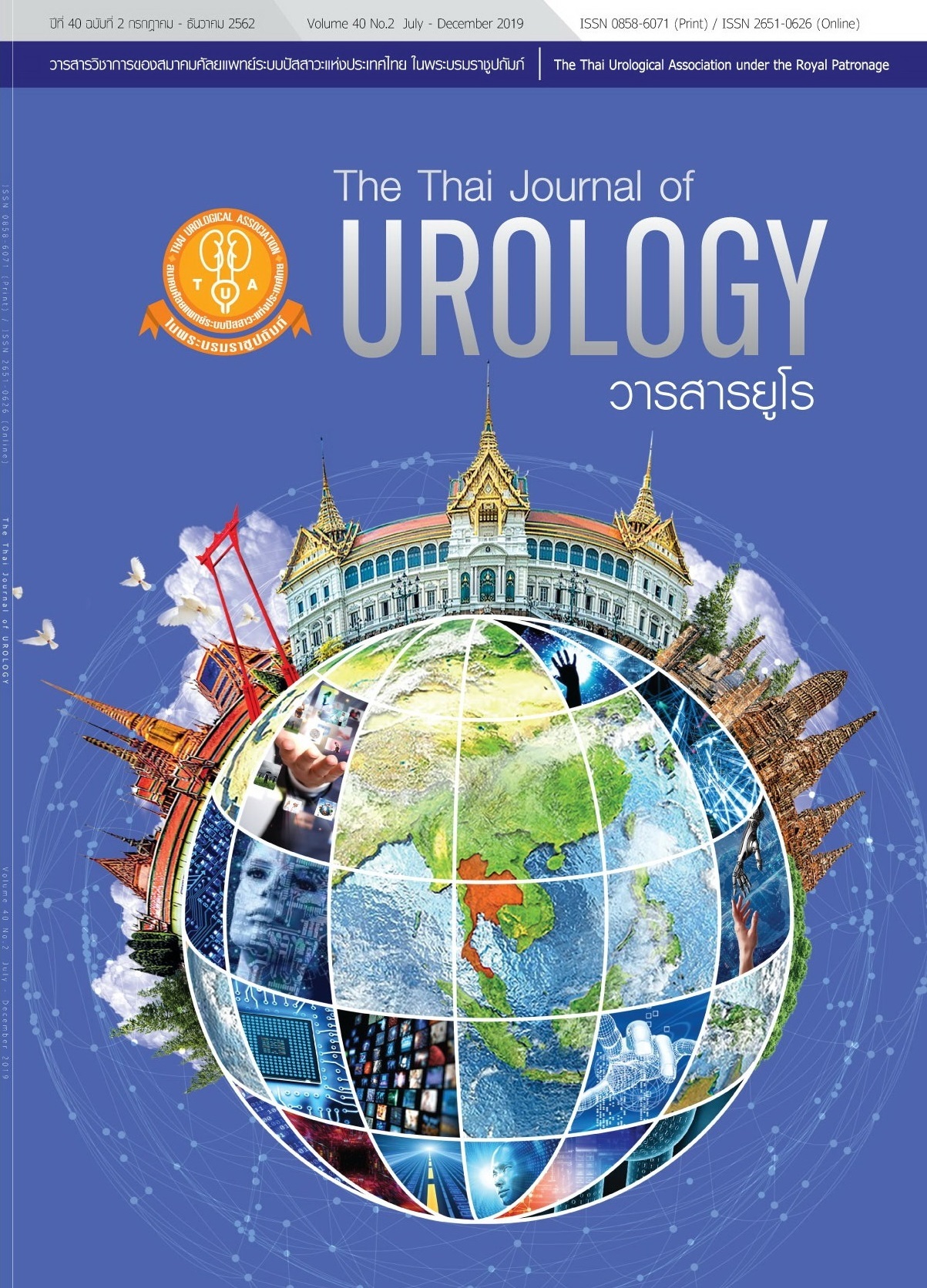Prostate cancer detection using MRI ultrasound fusion-guided biopsy compared with saturation biopsy in patients with prior negative biopsies in King Chulalongkorn Memorial Hospital
Keywords:
Multiparametric magnetic resonance imaging, Magnetic resonance imaging ultrasound fusion-guided prostate biopsy, Prostate cancer, Saturation biopsy, Prior negative biopsyAbstract
Background:Magnetic resonance imaging (MRI) ultrasound fusion-guided prostate biopsy (MRGB) and saturation biopsy (SB) are both alternative techniques to standard transrectal ultrasound-guided biopsy in the setting of repeat biopsy. Nevertheless, comparative evidence of the efficacy of both techniques remains unclear.
Objective:To compare prostate cancer (PCa) detection between MRGB and SB in patients with history of at least one prior negative prostate biopsy and prostate-specific antigen (PSA) ≥4 ng/ml.
Material and Methods:Between November, 2015 and December, 2018, a total 82 men with prior negative biopsies and persistent elevated PSA underwent MRGB combination with subsequent SB in our institution. Their charts were retrospectively reviewed. In our institution, MRGB was performed at the lesions scored 3-5 by Prostate Imaging Reporting and Data System (PI-RADS) on MRI. The primary outcome was the PCa detection. Secondary outcomes were the detection rate of significant PCa (Gleason ≥7) , histopathologic details of biopsy, complication rate. Sensitivity, specificity, negative predictive values (NPVs), and positive predictive values (PPVs) were reported.
Results:of 82 men, 39 (47.6%) had PCa. Overall PCa detection rate were 37.8% by MRGB and 31.7% by SB (95% confidence interval for difference, -6.0% to 18.1%; p = 0.27). The estimated sensitivity of MRGB and SB for overall PCa detection were 79.5% and 66.7%, respectively. The highest positive rate was among PI-RADS score of 5 (80%), followed by score of 4 (26%) and 3 (12%).
Conclusions:In setting of repeat biopsy, PCa detection rate by MRGB was better than SB insignificantly in our institution. MRGB was also found to have better sensitivity to overall PCa detection than SB.
References
2. Serag H, Banerjee S, Saeb-Parsy K, Irving S, Wright K, Stearn S, et al. Risk profiles of prostate cancers identified from UK primary care using national referral guidelines. Brit J Cancer 2012;106:436-9.
3. Cormio L, Scattoni V, Lorusso F, Perrone A, Di Fino G, Selvaggio O, et al. Prostate cancer detection rates in different biopsy schemes. Which cores for which patients? World J Urol 2014;32:341-6.
4. Arsov C, Rabenalt R, Blondin D, Quentin M, Hiester A, Godehardt E, et al. Prospective Randomized Trial Comparing Magnetic Resonance Imaging (MRI)-guided In-bore Biopsy to MRI-ultrasound Fusion and Transrectal Ultrasound-guided Prostate Biopsy in Patients with Prior Negative Biopsies. European Urology 2015;68:713-20.
5. Stewart CS, Leibovich BC, Weaver AL, Lieber MM. Prostate cancer diagnosis using a saturation needle biopsy technique after previous negative sextant biopsies. J Urology 2001;166:86-91.
6. Ashley RA, Inman BA, Routh JC, Mynderse LA, Gettman MT, Blute ML. Reassessing the diagnostic yield of saturation biopsy of the prostate. European Urology 2008;53:976-83.
7. Heidenreich A, Bastian PJ, Bellmunt J, Bolla M, Joniau S, van der Kwast T, et al. EAU guidelines on prostate cancer. part 1: screening, diagnosis, and local treatment with curative intent-update 2013. Eur Urol 2014;65:124-37.
8. Mottet N, Bellmunt J, Bolla M, Briers E, Cumberbatch MG, De Santis M, et al. EAUESTRO-SIOG Guidelines on Prostate Cancer. Part 1: Screening, Diagnosis, and Local Treatment with Curative Intent. European Urology 2017; 71:618-29.
9. Logan JK, Rais-Bahrami S, Turkbey B, Gomella
A, Amalou H, Choyke PL, et al. Current status of magnetic resonance imaging (MRI) and ultrasonography fusion software platforms for guidance of prostate biopsies. BJU International 2014;114:641-52.
10. Raskolnikov D, Rais-Bahrami S, Turkbey B, Rastinehad AR, Choyke PL, Wood BJ, et al. Current Ability of Multiparametric Prostate Magnetic Resonance Imaging and Targeted Biopsy to Improve the Detection of Prostate Cancer. Urol Pract 2014;1:13-21.
11. Barentsz JO, Weinreb JC, Verma S, Thoeny HC, Tempany CM, Shtern F, et al. Synopsis of the PI-RADS v2 Guidelines for Multiparametric Prostate Magnetic Resonance Imaging and
Recommendations for Use. Eur Urol 2016;69:41-9.
12. Fütterer JJ, Briganti A, De Visschere P, Emberton M, Giannarini G, Kirkham A, et al. Can Clinically Significant Prostate Cancer Be Detected with Multiparametric Magnetic Resonance Imaging? A Systematic Review of the Literature. European Urology 2015;68:1045-53.
13. Siddiqui MM, Rais-Bahrami S, Turkbey B, George AK, Rothwax J, Shakir N, et al. Comparison of MR/ultrasound fusion-guided biopsy with ultrasound-guided biopsy for the diagnosis of prostate cancer. JAMA 2015;313:390-7.
14. Kasivisvanathan V, Rannikko AS, Borghi M, Panebianco V, Mynderse LA, Vaarala MH, et al. MRI-Targeted or Standard Biopsy for ProstateCancer Diagnosis. New England Journal of Medicine 2018;378:1767-77.


